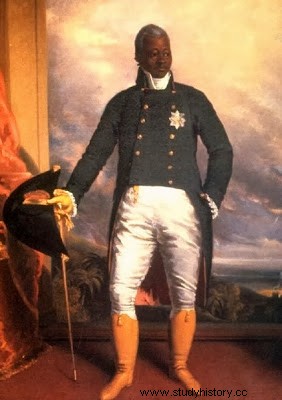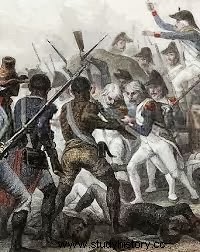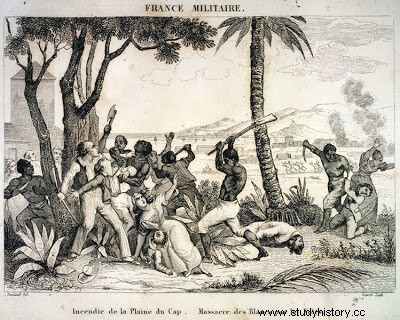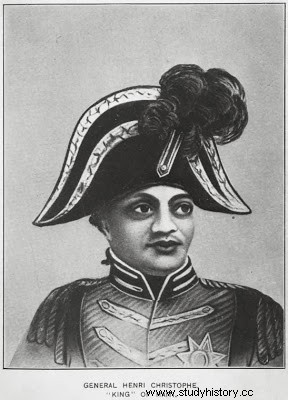Little is known about the childhood of Henri Christophe . Most historians agree that he was born on the island of Grenada, in the Caribbean, the son of a former slave. His father, also named Christophe, had arrived on a slave ship from West Africa to Santo Domingo, the former French colony now known as Haiti.

Henry Christophe
When little Henri was still a teenager, he joined the French army on the island as a drummer. The French had a regiment of former slaves whom they called gens de couleur . This regiment of free blacks was sent by the French to the United States to support the independence rebels in their war against England. Most of them fought in the fields of Savannah, in what is now the southern state of Georgia. Nine years later, in 1788, Georgia would become the fourth state admitted to the original thirteen colonies of the United States of America.

Haitian slaves fighting for Independence from the US
After fighting in the American Revolution, the Black Men's Regiment returned to the island of Santo Domingo (as it was then called). Henri Christophe made a living as a carpenter, mason, waiter, and cook. He came, by chance of life, to manage a hotel restaurant in Cabo Francés, at that time, the capital of Santo Domingo, where he served his exclusive clientele who were the rich French slave owners from the surrounding plantations. By 1789, Santo Domingo produced 60% of the coffee and 40% of the sugar in the world and all the production was taken to France and Great Britain. The colony became the most profitable possession of the French Empire. Santo Domingo was also home to the richest and most prosperous plantation owners of all the Caribbean colonies. In the census of that year, 40,000 whites, 28,000 mulattoes and free blacks and almost half a million black slaves were registered. Black slaves outnumbered whites and free mulattos by a ratio of 7 to 1.
At first, the news of the French Revolution was very well received on the island. The landowning whites saw it as an opportunity to gain independence from France, which would allow the elite to take control of the island and create their own trade regulations to increase their wealth and power. The slaves began to hear rumors that the rich landowners wanted to become independent on their own and that the coffee trade with France was seriously affected. As strange as it may sound, most slaves sided with the French monarchists because they believed that if Santo Domingo became independent, the treatment they would receive from their white overseers would be even harsher, as the plantation owners would handle slavery at their will. whim and without the slightest accountability to their French peers. At this point it is convenient to clarify that many former slaves had made great fortunes with their land and crops, but no matter how much money they had, segregation and treatment for all men of color was demeaning.
In France, the French Revolution was in full swing. In October 1790, Vincent Ogé , a wealthy free man of color, returned from his Paris home to the news that France's Constituent Assembly had passed a law giving full civil rights to "rich men of color." «. Ogé and another group of wealthy former slaves demanded the right to vote. When the island's governor refused to listen to his pleas, Ogé led a brief insurgency in Cape Frances. He was captured and brutally executed, first breaking all his bones "on the wheel", before being beheaded. Although Ogé was not fighting for slavery, strictly speaking, this act motivated the famous Slave Revolt in August 1791 , which began a civil war that lasted thirteen years and ended first with the abolition of slavery and then with the independence of Santo Domingo, to which its first president, the mulatto Jaques Dessalines , changed its name, baptizing it as Haiti . They started as an independent nation on January 1, 1804.
Jacques Dessalines did not trust the white French. He decided that the best thing would be to carry out an ethnic cleansing and between February and April 1804 he exterminated almost all the whites who lived on the island, in what is known as the Massacre of Haiti in 1804. Dessalines declared Haiti an entirely black nation and prohibited whites from owning land or property there.

Haiti was the first independent nation in Latin America, the first independent black country in the world, and the only successful slave rebellion that ended as a free state.
Now back to our protagonist. Henri Christophe he excelled in the civil war and over time went from being an obscure tavern cook to General of the rebel army in 1802. Barely two years after the new country was formed, a coup d'état was staged against Jacques Dessalines and the insurgent military took over control of the north of the country. Between roosters and midnight, Henri proclaimed himself president of the «State » from Haiti in 1807, but Alexandre Pétion , his main accomplice, soon became his worst enemy when he also declared himself president of the " Republic » from Haiti, but in the southern part of the country. So Haiti was divided in two.
Not to be outdone, Henry Christophe proclaimed himself king in 1811, converted the State of Haiti (the northern part) into a kingdom and ruled under the name of Henry I of Haiti . He had himself crowned by an archbishop and published an edict with his new name…
Henry I by the grace of God and the constitutional law of the State, King of Haiti, Sovereign of Tortuga, Gonâve and other adjacent islands, Destroyer of tyranny, Regenerator and Benefactor of the Haitian nation, creator of its moral, political and his army, First Crowned Monarch of the New World, Defender of the faith, founder of the Royal Military Order of Saint Henry.
Already as king, Christophe created a Haitian nobility to suit him, made up of four princes, eight dukes, twenty-two counts, forty barons and fourteen knights. In Europe they made fun of that, and the term «Haitian nobility » became synonymous with any makeshift aristocracy.

With his masonry experience, he himself directed the construction of six castles, eight palaces and the enormous Citadel Laferrière on top of mount L’Eveque at 910 m. A colossal building of more than 10,000 m2, whose outer walls were 40 meters high. It took 20,000 workers and fifteen years (1805-1820) to shape it. Its walls were built with a mortar containing lime, molasses, bull blood, goats and their respective ground hooves , which, according to his beliefs, added strength and cohesion to the mix.

From the fortress you could see Cap Haitien (former French Cape) and control the Atlantic Ocean. In fact, on clear days from the top, you can see the eastern coast of Cuba, which is 140 km away. It was built so that in the event of a possible foreign invasion or internal uprising, his army could burn the coastal crops and food reserves and retreat to the fortress, activating ambushes on the slopes of the mountain.
In his capacity as monarch, Christophe offered the governor of the southern part of the country, Alexandre Petion, the opportunity to be absorbed into the kingdom, which Petion refused, making relations between them always tense.
In August 1820, Christophe suffered a stroke that left most of his body immobilized. When the news of his illness spread, the whole country revolted against the tyrant; the town was already fed up with being forced to work without pay in its enormous constructions. But the worst thing for Henri Christophe was that the insurrection also broke out internally, inside his fortress, between his own guards and his army. The military garrison at San Marcos led a mutiny that sparked a riot. The mutiny coincided with a conspiracy by Christophe's own generals. Some of his trusted advisors wanted to remove him from the Citadel to avoid confrontation with the rebels climbing the mountain, but he refused. Christophe ordered his assistants to bathe him, dress him in his military uniform, place him in his favorite chair in the bedroom, and leave him alone.

Henry I of Haiti
Shortly after his assistants left him, a shot was heard. Christophe committed suicide by shooting himself in the heart with a silver bullet on October 8, 1820. His few faithful followers submerged his body in quicklime and buried it in one of the inner courtyards of the Citadel to prevent the incoming hordes. mutilate and desecrate the corpse. In the rebellion that followed after his death, his son, the Dauphin Víctor Enrique , was lynched by the rebels and with him the Christophe dynasty came to an end, since Henry I had imposed the Salic law, which did not allow women to ascend the throne or transmit rights to their descendants.
Collaboration of Carlos Suasnavas
Sources:The Kingdom of this world – Alejo Carpentier. 1, 2, 3, 4, 5
